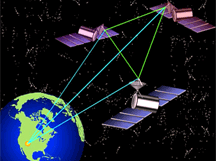According to an article in last Friday's London Evening Standard, the term 'pinging' means locating a mobile phone by satellite. Now Wireless Waffle has previously explained that GPS satellites can not track your location due to the fact that they only transmit location information, not receive it. So how did the News of the World manage to 'ping' the location of a mobile phone using satellite?
 As it couldn't have been GPS, the most obvious solution is that the satellites used to deliver Sky television are not just 'Sky satellites' but 'spy satellites' too! For this to work, the satellites concerned would have to be able to receive a signal from the phone being tracked, identify the direction from which the signal was being received, and then triangulate this through measurements from a number of different locations.
As it couldn't have been GPS, the most obvious solution is that the satellites used to deliver Sky television are not just 'Sky satellites' but 'spy satellites' too! For this to work, the satellites concerned would have to be able to receive a signal from the phone being tracked, identify the direction from which the signal was being received, and then triangulate this through measurements from a number of different locations.
 Let's take these one at a time. A geostationary satellite can 'see' about a third of the surface area of the earth. The image on the right shows the view from a satellite sat directly above the Greenwich Meridian. This puts it in clear line-of-sight of at least a third of the Earth's population (and probably more given that the pacific area is largely empty). So could it 'see' a mobile phone in the UK, yes! However, it would also see around a billion other mobile phones. Even if it had a very sharp 'spot beam' focussed solely on the UK (and remember that some celebrities may not be in the UK when pinged) it would still see probably a hundred million phones. Identifying the particular one being used by a certain individual is therefore not at all straightforward. Modern digital signal processing might be able to help a little, but with millions of mobile phones all transmitting at the same time, right across the country, it would take an awful lot of processing to pinpoint just one phone.
Let's take these one at a time. A geostationary satellite can 'see' about a third of the surface area of the earth. The image on the right shows the view from a satellite sat directly above the Greenwich Meridian. This puts it in clear line-of-sight of at least a third of the Earth's population (and probably more given that the pacific area is largely empty). So could it 'see' a mobile phone in the UK, yes! However, it would also see around a billion other mobile phones. Even if it had a very sharp 'spot beam' focussed solely on the UK (and remember that some celebrities may not be in the UK when pinged) it would still see probably a hundred million phones. Identifying the particular one being used by a certain individual is therefore not at all straightforward. Modern digital signal processing might be able to help a little, but with millions of mobile phones all transmitting at the same time, right across the country, it would take an awful lot of processing to pinpoint just one phone.
Let's assume (for the sake of argument) that such processing could be fitted to a satellite and that it was possible to pick out one phone from amongst millions. The next job is to identify the direction of the signal from that phone. In order to do this to an accuracy of, say 1km, from geostationary orbit, requires an angular accuracy of about 0.01 degrees. To get this level of focus requires an antenna array that is approximately 1km across, nearly 100 times the maximum size of antennas fitted to current communication satellites.
 So assuming state-of-the-art digital signal processing, and satellites that are 100 times the size of those typically in use, all that remains is to triangulate the location of the transmitter. Typically three measurements are required in order to triangulate the location of an object. All the UK Sky TV satellites are in the same orbital position, but this would not give the level of diversity required and so satellites in other positions would need to be used in addition to the fleet used for the UK services. But as there are Sky TV services for other countries on other satellites in diverse orbital positions, these could be used. This bit, at least, is vaguely feasible.
So assuming state-of-the-art digital signal processing, and satellites that are 100 times the size of those typically in use, all that remains is to triangulate the location of the transmitter. Typically three measurements are required in order to triangulate the location of an object. All the UK Sky TV satellites are in the same orbital position, but this would not give the level of diversity required and so satellites in other positions would need to be used in addition to the fleet used for the UK services. But as there are Sky TV services for other countries on other satellites in diverse orbital positions, these could be used. This bit, at least, is vaguely feasible.
So with a fleet of gigantic, super-powerful, mega-satellites, it might just be possible to identify the location of a mobile phone from space. It is more likely, however, that the idea that 'pinging' a phone to locate it by satellite is pure hogwash, and is an idea espoused by the press to scare celebrities and others (like you and me) into thinking that they can be tracked down when up to no good!

 As it couldn't have been GPS, the most obvious solution is that the satellites used to deliver Sky television are not just 'Sky satellites' but 'spy satellites' too! For this to work, the satellites concerned would have to be able to receive a signal from the phone being tracked, identify the direction from which the signal was being received, and then triangulate this through measurements from a number of different locations.
As it couldn't have been GPS, the most obvious solution is that the satellites used to deliver Sky television are not just 'Sky satellites' but 'spy satellites' too! For this to work, the satellites concerned would have to be able to receive a signal from the phone being tracked, identify the direction from which the signal was being received, and then triangulate this through measurements from a number of different locations.  Let's take these one at a time. A geostationary satellite can 'see' about a third of the surface area of the earth. The image on the right shows the view from a satellite sat directly above the Greenwich Meridian. This puts it in clear line-of-sight of at least a third of the Earth's population (and probably more given that the pacific area is largely empty). So could it 'see' a mobile phone in the UK, yes! However, it would also see around a billion other mobile phones. Even if it had a very sharp 'spot beam' focussed solely on the UK (and remember that some celebrities may not be in the UK when pinged) it would still see probably a hundred million phones. Identifying the particular one being used by a certain individual is therefore not at all straightforward. Modern digital signal processing might be able to help a little, but with millions of mobile phones all transmitting at the same time, right across the country, it would take an awful lot of processing to pinpoint just one phone.
Let's take these one at a time. A geostationary satellite can 'see' about a third of the surface area of the earth. The image on the right shows the view from a satellite sat directly above the Greenwich Meridian. This puts it in clear line-of-sight of at least a third of the Earth's population (and probably more given that the pacific area is largely empty). So could it 'see' a mobile phone in the UK, yes! However, it would also see around a billion other mobile phones. Even if it had a very sharp 'spot beam' focussed solely on the UK (and remember that some celebrities may not be in the UK when pinged) it would still see probably a hundred million phones. Identifying the particular one being used by a certain individual is therefore not at all straightforward. Modern digital signal processing might be able to help a little, but with millions of mobile phones all transmitting at the same time, right across the country, it would take an awful lot of processing to pinpoint just one phone.Let's assume (for the sake of argument) that such processing could be fitted to a satellite and that it was possible to pick out one phone from amongst millions. The next job is to identify the direction of the signal from that phone. In order to do this to an accuracy of, say 1km, from geostationary orbit, requires an angular accuracy of about 0.01 degrees. To get this level of focus requires an antenna array that is approximately 1km across, nearly 100 times the maximum size of antennas fitted to current communication satellites.
 So assuming state-of-the-art digital signal processing, and satellites that are 100 times the size of those typically in use, all that remains is to triangulate the location of the transmitter. Typically three measurements are required in order to triangulate the location of an object. All the UK Sky TV satellites are in the same orbital position, but this would not give the level of diversity required and so satellites in other positions would need to be used in addition to the fleet used for the UK services. But as there are Sky TV services for other countries on other satellites in diverse orbital positions, these could be used. This bit, at least, is vaguely feasible.
So assuming state-of-the-art digital signal processing, and satellites that are 100 times the size of those typically in use, all that remains is to triangulate the location of the transmitter. Typically three measurements are required in order to triangulate the location of an object. All the UK Sky TV satellites are in the same orbital position, but this would not give the level of diversity required and so satellites in other positions would need to be used in addition to the fleet used for the UK services. But as there are Sky TV services for other countries on other satellites in diverse orbital positions, these could be used. This bit, at least, is vaguely feasible.So with a fleet of gigantic, super-powerful, mega-satellites, it might just be possible to identify the location of a mobile phone from space. It is more likely, however, that the idea that 'pinging' a phone to locate it by satellite is pure hogwash, and is an idea espoused by the press to scare celebrities and others (like you and me) into thinking that they can be tracked down when up to no good!

1 comment
( 1701 views )
| permalink
| 



 ( 2.9 / 101429 )
( 2.9 / 101429 )




 ( 2.9 / 101429 )
( 2.9 / 101429 )

